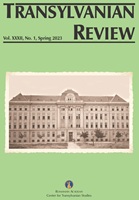Kultur und Werte, Blut und Boden: Siebenbürgisch-sächsische Biopolitik in den „langen“ 1920er-Jahren
Culture and Values, Blood and Soil: Transylvanian Saxon Biopolitics in the “Long 1920s”
Author(s): Florian Kührer-WielachSubject(s): Political history, Social history, Health and medicine and law, Interwar Period (1920 - 1939), Ethnic Minorities Studies
Published by: Academia Română – Centrul de Studii Transilvane
Keywords: eugenics; Transylvanian Saxons; Romanian Germans; interwar period; race theory; minority;
Summary/Abstract: The paper deals with the topic of eugenics (“Erbgesundheitslehre” or “Rassenhygiene”) among the Germans in Romania, which was mainly carried by Transylvanian Saxon actors. Based on Tudor Georgescu’s monograph The Eugenic Fortress: The Transylvanian Saxon Experiment in Interwar Romania (2016), the topic is analyzed in depth for the 1920s. Using Heinrich Siegmund’s Sächsisches Wehr- und Mehrbuch, which was published in 1914 and in a revised form in 1922, as well as other source examples, it is shown that the eugenic discourse was not only a transfer from the “West” to Transylvanian Saxony, but took on a specific form. The central actors of the biopolitical discourse among the Transylvanian Saxons, especially Heinrich Siegmund and later Alfred Csallner, acted in an interpersonal and intertextual network, especially one supported by institutions, that was primarily connected to Germany—the exchange on eugenics was thus a reciprocal process, not an exclusively one-sided “import” from the “West.” However, it is further noted that there was relatively little demonstrable exchange with Romanian and Hungarian eugenicists. The implementation of the teachings of eugenics was intended to counter a demographically induced decrease in the population of the German minority. The main target was the younger generation, especially in rural areas—this milieu was seen as having the best chances of resisting the “decline” by means of biopolitical measures. On the one hand, the analyzed discourse reveals the intertwining of traditional and contemporary topoi; on the other hand, a radicalization of biopolitical concepts can be seen parallel to political developments.
Journal: Transylvanian Review
- Issue Year: XXXII/2023
- Issue No: 1
- Page Range: 63-85
- Page Count: 23
- Language: German

